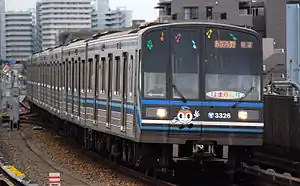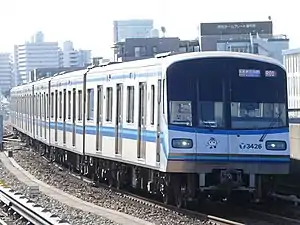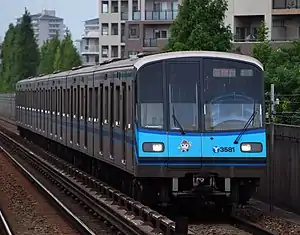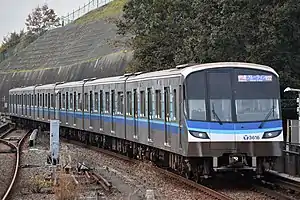Yokohama Municipal Subway 3000 series
The Yokohama Municipal Subway 3000 series (横浜市交通局3000形) is a commuter electric multiple unit (EMU) train type operated by the Yokohama City Transportation Bureau on the Yokohama Municipal Subway Blue Line in Japan since 1992.[2]
| Yokohama Municipal Subway 3000 series | |
|---|---|
 3000A series set 26 (left) and 3000R series set 45 (right), December 2021 | |
| Constructed | 1992– |
| Entered service | 1992 |
| Number built | 228 vehicles (38 sets) |
| Number in service | 216 vehicles (36 sets) (as of April 2020) |
| Number scrapped | 12 vehicles (2 sets; accident damage)[1] |
| Formation | 6 cars per trainset |
| Fleet numbers | 24–61 |
| Operator(s) | |
| Depot(s) | Kaminagaya |
| Line(s) served | |
| Specifications | |
| Car body construction | Stainless steel |
| Car length |
|
| Width | 2.76 m (9 ft 1 in) |
| Height | 3.54 m (11 ft 7 in) |
| Floor height | 1.04 m (3 ft 5 in) |
| Doors | 3 pairs per side |
| Maximum speed | 90 km/h (55 mph) |
| Traction system | Mitsubishi Electric VVVF drive |
| Traction motors | 16 × Mitsubishi 140 kW (190 hp) 3-phase AC induction motor |
| Power output | 2.24 MW (3,000 hp) |
| Acceleration | 0.89 m/s2 (2.9 ft/s2) |
| Deceleration | 0.97 m/s2 (3.2 ft/s2) (service) 1.3 m/s2 (4.3 ft/s2) (emergency) |
| Electric system(s) | 750 V DC third rail |
| Current collector(s) | Contact shoe |
| Safety system(s) | ATC/ATO |
| Track gauge | 1,435 mm (4 ft 8+1⁄2 in) standard gauge |
Variants
The type is subdivided into the following variants, each formed as 6-car sets.[2]
- 3000A series: 8 sets, introduced in 1992
- 3000N series: 7 sets, introduced in 1999
- 3000R series: 14 sets, introduced in 2004
- 3000S series: 8 sets, introduced in 2006
- 3000V series: 1 set, introduced in April 2017
3000A series
| 3000A series | |
|---|---|
 3000A series set 24 in May 2019 | |
| Manufacturer | Tokyu Car Corporation |
| Entered service | 1992 |
| Number built | 48 vehicles (8 sets) |
| Number in service | 48 vehicles (8 sets) (as of 1 April 2016) |
| Successor | 4000 series |
| Fleet numbers | 24–31 |
| Specifications | |
| Traction system | MAP-148-75V32 GTO–VVVF |
| Traction motors | SEA-331 |
The 3000A series trainsets were introduced from 1992.[2] They are due to be replaced by new 4000 series EMUs from 2022.[3]
Formation
As of 1 April 2016, eight six-car sets (24 to 31) are in service, formed as follows, with car 1 at the Shonandai end.[4]
| Car No. | 1 | 2 | 3 | 4 | 5 | 6 |
|---|---|---|---|---|---|---|
| Designation | Tc1 | M2 | M3 | M4 | M5 | Tc6 |
| Numbering | 3xx1 | 3xx2 | 3xx3 | 3xx4 | 3xx5 | 3xx6 |
Interior
 Interior of a 3000A series set
Interior of a 3000A series set A transverse seating bay immediately behind the driver's cab in a 3000A series train
A transverse seating bay immediately behind the driver's cab in a 3000A series train
3000N series
| 3000N series | |
|---|---|
 3000N series set 32 in September 2010 | |
| Manufacturer | Tokyu Car Corporation |
| Entered service | 1999 |
| Number built | 42 vehicles (7 sets) |
| Number in service | 36 vehicles (6 sets) (as of 1 April 2020) |
| Number scrapped | 6 vehicles (set 38; accident damage)[1] |
| Fleet numbers | 32 - 38 |
| Specifications | |
| Traction system | MAP-148-75V77 IGBT–VVVF |
| Traction motors | MB-5080-A |
The 3000N series trainsets were introduced from 1999, and featured a new front-end design, while retaining the ribbed stainless body construction of the earlier 3000A series trains.[2]
Formation
As of 1 April 2016, seven six-car sets (32 to 38) are in service, formed as follows, with car 1 at the Shonandai end.[4]
| Car No. | 1 | 2 | 3 | 4 | 5 | 6 |
|---|---|---|---|---|---|---|
| Designation | Tc1 | M2 | M3 | M4 | M5 | Tc6 |
| Numbering | 3xx1 | 3xx2 | 3xx3 | 3xx4 | 3xx5 | 3xx6 |
3000R series
| 3000R series | |
|---|---|
 3000R series set 42 in October 2019 | |
| Manufacturer | Nippon Sharyo |
| Number built | 84 vehicles (14 sets) |
| Number in service | 84 vehicles (14 sets) (as of 1 April 2016) |
| Fleet numbers | 39 - 52 |
| Specifications | |
| Traction system | MAP-148-75V77A IGBT–VVVF |
| Traction motors | MB-5080-A |
The 3000R series trainsets were introduced from 2004 to replace the ageing 1000 series sets.[2] These trains have stainless steel bodies with smooth sides.[2]
Formation
As of 1 April 2016, 14 six-car sets (39 to 52) are in service, formed as follows, with car 1 at the Shonandai end.[4][5]
| Car No. | 1 | 2 | 3 | 4 | 5 | 6 |
|---|---|---|---|---|---|---|
| Designation | Tc1 | M2 | M3 | M4 | M5 | Tc6 |
| Numbering | 3xx1 | 3xx2 | 3xx3 | 3xx4 | 3xx5 | 3xx6 |
| Weight (t) | 30 | 35 | 33 | 33 | 33 | 30 |
| Capacity (total) | 122 | 133 | 133 | 133 | 133 | 122 |
Interior
Passenger accommodation consists of longitudinal seating throughout.
 Interior view
Interior view Priority seating
Priority seating
3000S series
| 3000S series | |
|---|---|
 3000S series set 58 in September 2010 | |
| Manufacturer | Nippon Sharyo |
| Number built | 48 vehicles (8 sets) |
| Number in service | 42 vehicles (7 sets) (as of 1 April 2020) |
| Number scrapped | 6 vehicles (set 53; accident damage)[1] |
| Fleet numbers | 53 - 60 |
| Specifications | |
| Traction system | MAP-148-75V77A IGBT–VVVF |
| Traction motors | MB-5080-A |
The 3000S series trainsets were introduced from 2006, and were built with same body design as the earlier 3000R series trains, but using the bogies, brakes, and ATC equipment from withdrawn 2000 series trainsets.[2][4]
Formation
As of 1 April 2016, eight six-car sets (53 to 60) are in service, formed as follows, with car 1 at the Shonandai end.[4]
| Car No. | 1 | 2 | 3 | 4 | 5 | 6 |
|---|---|---|---|---|---|---|
| Designation | Tc1 | M2 | M3 | M4 | M5 | Tc6 |
| Numbering | 3xx1 | 3xx2 | 3xx3 | 3xx4 | 3xx5 | 3xx6 |
3000V series
| 3000V series | |
|---|---|
 3000V series set 61 in December 2019 | |
| Manufacturer | Nippon Sharyo |
| Entered service | April 2017 |
| Number built | 6 vehicles (1 set) (as of April 2017) |
| Number in service | 6 vehicles (1 set) |
| Fleet numbers | 61 |
| Specifications | |
| Traction system | MAP-148-75V303 SiC hybrid IGBT–VVVF |
| Traction motors | MB-5170-A |
Introduced in April 2017, the 3000V series is based on the earlier 3000R series design.[5] The "V" classification was chosen using the Roman numeral for "5", as the 3000V series represents the fifth batch of 3000 series trains.[5]
The first 3000V series set (61) entered service on 9 April 2017.[6] A total of seven sets were scheduled to be introduced by 2022 to replace the earlier 3000A series trainsets. However this plan was abandoned in favour of newer 4000 series cars.[7][8]
Formation
As of April 2017, one six-car set (61) is in service, formed as follows, with car 1 at the Shonandai end.[5]
| Car No. | 1 | 2 | 3 | 4 | 5 | 6 |
|---|---|---|---|---|---|---|
| Designation | Tc1 | M2 | M3 | M4 | M5 | Tc6 |
| Numbering | 3xx1 | 3xx2 | 3xx3 | 3xx4 | 3xx5 | 3xx6 |
| Weight (t) | 32.0 | 35.5 | 33.5 | 35.5 | 34.0 | 31.5 |
| Capacity (total) | 122 | 133 | 133 | 133 | 133 | 122 |
References
- "横浜市 市民局 広聴相談課 「市民の声」の公表(詳細)".
- Takai, Kunpei (30 June 2014). Morokawa, Hisashi; Hattori, Akihiro (eds.). 全国私鉄超決定版電車・機関車・気動車1700 全国私鉄超決定版 電車・機関車・気動車1700 [Nationwide Private Railway Ultimate Edition: 1700 EMUs, Locomotives, and DMUs] (in Japanese). Tokyo, Japan: Sekaibunka-sha. p. 69. ISBN 978-4-418-14219-4.
- "横浜市営地下鉄ブルーラインに4000形を導入" [Yokohama Municipal Subway to introduce new 4000 series vehicles on the Blue Line]. Japan Railfan Magazine Online (in Japanese). Koyusha Co., Ltd. 13 December 2021. Retrieved 11 February 2022.
- 私鉄車両編成表 2016 [Private Railway Rolling Stock Formations - 2016] (in Japanese). Japan: Kotsu Shimbunsha. 25 July 2016. p. 81. ISBN 978-4-330-70116-5.
- 横浜市交通局3000V形 [Yokohama City Transportation Bureau 3000V series]. Japan Railfan Magazine (in Japanese). Vol. 57, no. 674. Japan: Koyusha Co., Ltd. June 2017. pp. 90–94.
- 横浜市交通局3000V形が営業運転を開始 [Yokohama Municipal Subway 3000V series enters revenue service]. Japan Railfan Magazine Online (in Japanese). Japan: Koyusha Co., Ltd. 10 April 2017. Archived from the original on 12 April 2017. Retrieved 5 May 2017.
- 4/9,横浜市交通局3000V形デビュー [9 April: Yokohama Municipal Subway 3000V series debut]. Japan Railfan Magazine (in Japanese). Vol. 57, no. 675. Japan: Koyusha Co., Ltd. July 2017. p. 155.
- "横浜市交通局向け地下鉄電車を受注" [Received an order for a subway train for the Yokohama City Transportation Bureau]. Kawasaki Online (in Japanese). 11 October 2018. Archived from the original on 21 July 2021. Retrieved 3 May 2022.